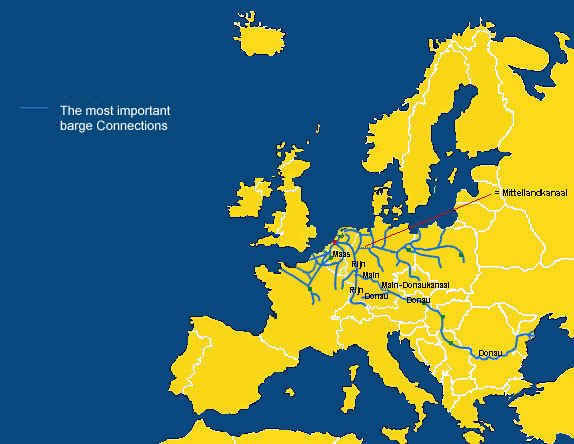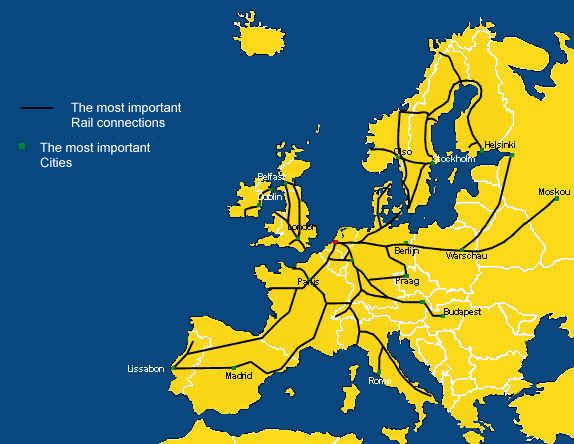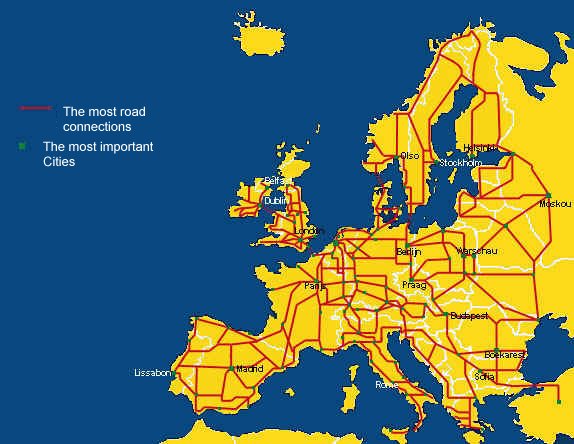
 |
Geografia d'Europa: textos de suport |
Rotterdam is the capital city of European container transport. Every year containers totalling almost 5 million TEU (1 TEU is a twenty-feet container) are handled in the Dutch port. This is more than any other European port. Furthermore, 70% of the containers handled in Rotterdam are destined for European regions outside the Netherlands. Almost all the intercontinental services of the big container shipping lines call at Rotterdam. From this strategically located port, containers are then forwarded to the other European countries by coastal shipping, barge, truck and train.
Rotterdam has been Europe's biggest container port for thirty years now. In 1997 containers totalling more than 5 million TEU were handled. The Rotterdam Municipal Port Management expects a throughput of around 11.3 million TEU by the year 2020.
Top 5 European container
ports x million TEU in 1997
| 1. | Rotterdam | 5.4 |
| 2. | Hamburg | 3.3 |
| 3. | Antwerp | 3.0 |
| 4. | Bremerhaven | 2.2 |
| 5. | Le Havre | 1.7 |
Worldwide Rotterdam occupies
fourth place on the list of the biggest container ports. It is surpassed
by only three Asian ports (Hongkong, Singapore and Kaohsiung). During the
last twenty years container throughput has increased enormously, particularly
in South-East Asia. This is due to the explosive development of industry
there and the interasian traffic.
FACILITIES AND TECHNOLOGY
Rotterdam clearly leads the way worldwide when it comes to container handling technology. In particular ECT (Europe Combined Terminals), the biggest container handling company in Rotterdam, has made a name for itself in the development and application of highly advanced terminal transport systems.
Sea terminals
The container terminals in Rotterdam are concentrated in two areas: Waalhaven/Eemhaven and Maasvlakte.
Waalhaven:
Uniport
Hanno
Eemhaven:
ECT Home
Rotterdam shortsea terminal
Maasvlakte:
ECT Delta Multi-User
ECT Delta Sea-Land
ECT Delta Dedicated East
ECT Delta Dedicated West (under development).
At the Delta Sea-Land terminal and the DDE terminal, the transport of containers from the quay cranes to the stack and positioning in the stack is fully automatic. The terminals are able to handle the very biggest ships, like the sixth-generation ships that carry over 6000 TEU. At the Delta terminals the cranes have an outreach of 16 containers, while account has been taken of ships 18 containers wide for the cranes to be used at the new terminals of the so-called Delta 2000-8 plan.
Inland terminals
Rotterdam has connections with numerous inland terminals in the Netherlands, Germany, Belgium and other European countries via inland waterways, the rail network and motorways. There the containers can be transferred from one mode of transport to another. Increasing use is being made of shuttle trains and inland shipping shuttles between Rotterdam and the inland terminal in the European hinterland.
Depots
In order to reduce costs,
shipping companies prefer to store, clean and repair their containers in
the close vicinity of a port. Many companies from Rotterdam and the surrounding
region carry out this work for the shipping companies. A number of them
are situated on the water, thereby enabling efficient and cheap transport
by barge or coastal shipping.
TRANSPORT TO THE HINTERLAND
Rotterdam reaches the European market in container transport by rail, by road transport or by water using coasters and barges. Few ports can offer so many possibilities.
Modal Split Container
transport (CBS 1996)
|
|
|
|
| Coastal shipping |
|
|
| Inland shipping |
|
|
| Rail |
|
|
| Road transport |
|
|
Rail
Rail still has a relatively small share (11 %) in hinterland transport. However, it is growing very rapidly. In 1997 40% more international containers were transported to and from Rotterdam than in the previous year. This is largely thanks to the shuttle trains (container trains that operate on a fixed schedule, to a fixed destination, with a fixed capacity). There are shuttle connections with five national and seventeen international destinations. Every week around 250 shuttle trains operate between Rotterdam and the most important industrial centres throughout Europe. Rail shuttles are an efficient, fast and cheap alternative for European transportation of containers and swap bodies.
The construction of the so-called Betuwe Line is very important for the transportation of containers in and out of the port by rail. This dedicated freight line, involving an investment of more than 8 billion guilders, will connect Rotterdam to the German railway network.
Inland shipping
Transport by barge along the Rhine is proving to be a cheap alternative for containers destined for the Rhine States and - via the Rhine-Main-Danube canal - also the Danube countries. Thanks to regular services to numerous inland and German terminals, inland shipping now has a 22% share of containers carried in and out of Rotterdam. Due to the growth in the number of inland container terminals in the hinterland and better logistics within the port, this share is likely to grow even bigger in the coming years.
Coastal shipping
Due to Rotterdam's strategic location, the container terminals on the Maasvlakte and in the Waalhaven/Eemhaven area are very suitable for the import and export of containers by coastal shipping. This is a good alternative to road transport, particularly for containers originating from or destined for European locations not far from seaports.
Road transport
Up until a few years ago,
containers were almost exclusively transported to and from the hinterland
by truck. Around 60% of this traffic has now been taken over by other modes
of transport. But with a 40% share, road transport is still the most important
means of transport for containers to and from the hinterland. This is precisely
why Rotterdam is continually improving its road infrastructure.
TRANSPORT CONNECTIONS
Rotterdam is the European hub for the transport of goods. There are scheduled sailings to over a thousand ports in the world from Rotterdam, a service which no other port can provide.
Deepsea: Rotterdam's front gate is wide open to the North Sea. Ships with a draught of up to 74 feet can enter the port fully laden via the Eurogeul. This means they can carry 300 to 350 thousand tonnes of crude oil, iron ore or coal at one time. But there are no limitations in Rotterdam for even the very large ships of 6000 TEU or more. Sailing schedules to 800 ports can be found quite easily on the sailing list published by Mediahaven Uitgevers bv.
Hinterland: The port offers the best starting-point for efficient intermodal transport. Door-to-door via a sophisticated combination of different modes of transport. Every location in Europe is accessible from Rotterdam in no time at all. A choice can be made between transport by truck, train, barge, coaster and - for liquid bulk - pipeline. The ideal mode of transport is available in the port for every type of cargo, volume of cargo, required speed and price.
Modal split freight transport
(CBS 1996)
|
|
|
|
| Shortsea/feeder |
|
|
| Barge |
|
|
| Rail |
|
|
| Road |
|
|
| Pipeline |
|
|
INLAND SHIPPING
The geographical location of the Rhine and Maas (Meuse) rivers gives Rotterdam an ideal starting point for European transport by water. For every type of cargo and every volume. Goods are carried into the heart of Europe by barge. For centuries inland shipping has formed the most important means of transporting all kinds of bulk cargo from Rotterdam, such as coal, iron ore and grain. Tankers and parcel ships also provide safe, environment-friendly transport of chemicals. Inland shipping now also plays a leading role in the transportation of containers. Approximately 30% of containers handled in Rotterdam travel by inland waterways. Inland shipping shuttles operate liner services to inland terminals deep in Germany, Switzerland, France and Belgium. Just-in-time is also an important aspect of inland shipping.
As a result of the opening of the Rhine-Main-Danube canal, inland shipping can now sail even deeper into Europe. Within just a short space of time, Rotterdam has developed into Austria's second import and export port. Many new opportunities are offered by Hungary and Romania.
Versatile and large:
one four-barge push combination = 385 trucks
one RoRo ship = 600 passenger cars
one container push-barge combination = 360 TEU

RAIL TRANSPORT
In view of the growing volumes, freight transport by train is the perfect alternative for efficient, problem-free and environment-friendly transport over the entire continent of Europe. Rotterdam Mainport Europe is the point of departure and terminus for trains for every type of cargo. The port of Rotterdam has rail links with all important industrial centres. A large part of Europe is accessible by train within 24-48 hours. Trains leave every hour of the day, including at the weekend!
The port of Rotterdam has two dedicated Rail Chemical Centres for the transportation of chemical products. Many large companies are fully aware that rail offers a safe, cheap and environment-friendly alternative for the transportation of chemicals.

ROAD TRANSPORT
The port has a perfect link with the extensive road network of Europe. The truck offers you tailor-made transport, for every type of cargo. If speed and flexibility have priority, the truck is the best choice. Every day in the port of Rotterdam, thousands of trucks travel to and from destinations in the heart of Europe. General cargo, temperature-controlled cargo, chemicals and containers: it is always possible from Rotterdam. Safe, without delays and at a very competitive price. Dutch drivers are renowned for their reliability, flexibility and international orientation. Connections with the European road network are excellent.

FUTURE AND FURTHER EXPANSION
Container transport is the fastest growing sub-market in the maritime transport sector. Between 1974 and 1997 container transport by ship increased eightfold. And the number is still growing. Rotterdam is responding to this development by expanding its facilities on the Maasvlakte and in the Eemhaven area.
Maasvlakte: Around 2.8 million TEU containers are handled annually on the Maasvlakte. But by the year 2010 a throughput of over 7 million containers is anticipated. A series of new terminals is currently under construction on the Maasvlakte within the framework of the Delta 2000-8 plan. The government and ECT are jointly investing around 2 billion guilders in this project. These terminals are intended for large, globally operating shipping lines who wish to have their own terminal facilities. The first phase, Delta Dedicated East, was completed in July 1996.
Eemhaven area: 'Plan
2000-short' is being implemented in the Eemhaven area specially to promote
the transportation of containers by coastal shipping. This plan is costing
200 million guilders. The coastal shipping centre provides accommodation
for the terminals dealing with the transshipment of cargo in and out of
coasters. This plan is in line with the European Commission's policy to
promote coastal shipping.
Fuente:
Port of Rotterdam
http://www.port.rotterdam.nl
Última actualització: 14 de Junio de 2002